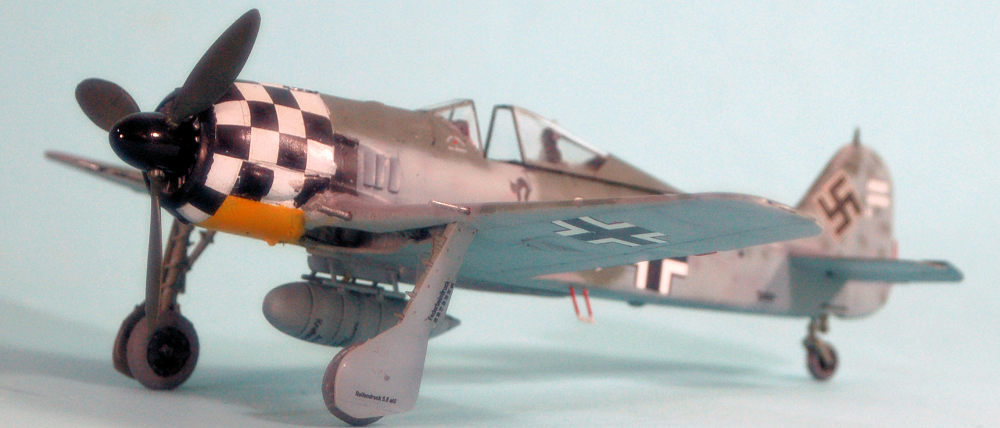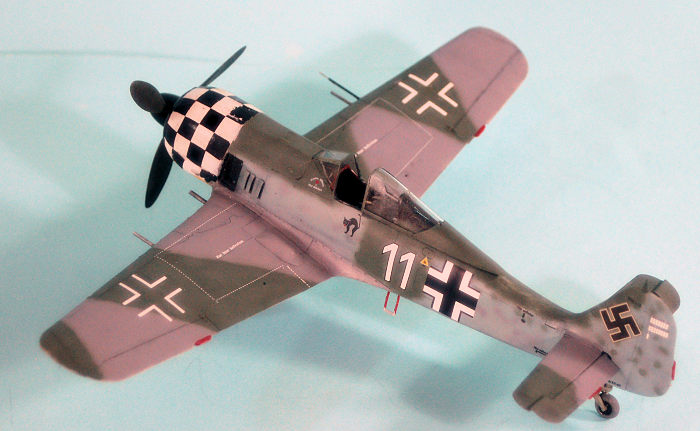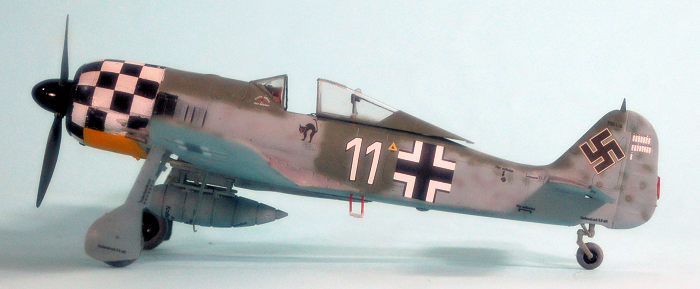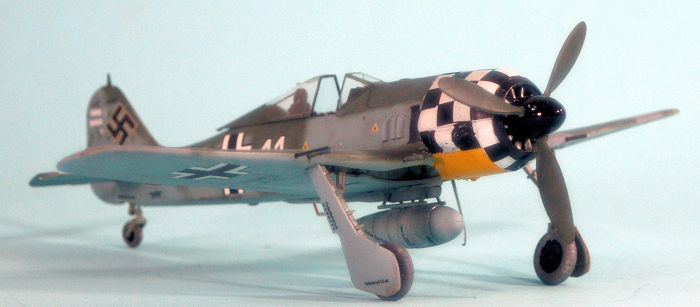
Dragon 1/48 FW-190A-6
| KIT #: | 2693 |
| PRICE: | $19.95 'used' |
| DECALS: | Five options |
| REVIEWER: | Tom Cleaver |
| NOTES: |
Italeri 'German Aces' release. |

| HISTORY |
The Fw-190A-6 was the last version of the “mid-range” Fw-190A series. As with the A-2, A-3, A-4 and A-5 sub-types, it had two 7.62mm machine guns mounted in the fuselage, for primary use as “sighting weapons.” Unlike the earlier versions, it dropped the outer-wing 20mm MG-FF drum-fed cannon - which had presented problems from the outset with its slower rate of fire and differing range and trajectory from the excellent 20mm MG 151 mounted in the wing roots - and provided an all-MG 151 armament. Still comparatively light weight, the Fw-190A-6 was the “last of the dog fighters,” and would be used on the Eastern Front in the air superiority role till the end of the war.
However, the main use of the Fw-190A-6 - and the reason for its existence with its heavy armament - was on the Western Front, where the USAAF’s 8th Air Force was gathering strength and reaching out across Western Europe and into Germany in the spring and summer of 1943 when the A-6 made its appearance.
 While
the Fw-190A was always the German fighter with the best armament for opposing
heavy bombers, it was at a disadvantage against the Americans, since the
Wurger’s best altitude performance was
at approximately 23,000 feet, and the American bombers were coming in at
25,000-27,000 feet. Thus, by the time the Fw-190-equipped units struggled up to
28,000 to 29,000 feet to make their famous “twelve o’clock high” head-on attacks
against the bombers, they were at a serious disadvantage if they ran across any
opposing P-47s - which would be operating at their best height at that altitude.
While
the Fw-190A was always the German fighter with the best armament for opposing
heavy bombers, it was at a disadvantage against the Americans, since the
Wurger’s best altitude performance was
at approximately 23,000 feet, and the American bombers were coming in at
25,000-27,000 feet. Thus, by the time the Fw-190-equipped units struggled up to
28,000 to 29,000 feet to make their famous “twelve o’clock high” head-on attacks
against the bombers, they were at a serious disadvantage if they ran across any
opposing P-47s - which would be operating at their best height at that altitude.
Thus, the Jagdgeschwadern opposing the Americans - JG 2 over the Cotentin Peninsula in western France, JG 26 in northern France and southern Belgium, and JG 1 in northern Belgium and Holland - were forced in the spring of 1943 to change from being solely equipped with Fw-190s in all Gruppen to having two Gruppen on the Fw-190 and the third flying the Bf-109G-2 and later Bf-109G-4, which could fly and fight at altitudes above 30,000 feet. The responsibility of the 109s was to cover the 190s and keep the fighters away while the 190s concentrated on the bombers. Unfortunately, the Germans were about as successful with this tactic as the RAF had been assigning Spitfires to cover Hurricanes and take on the Luftwaffe’s 109s while the Hurricanes took on the Heinkels and Dorniers during the Battle of Britain. As the summer of 1943 wore on and the P-47s of the 8th Air Force acquired the ability to reach out further from England to the west German border, the Fw-190s found themselves more and more frequently fighting off Thunderbolts while trying to set up for a “company front” attack on the bomber screen. It was in these early battles that the Luftwaffe began hemorrhaging the one commodity they couldn’t afford to lose: experienced pilots. Within six months of the first Schweinfurt mission in August 1943, the Jagdwaffe would be a shadow of its former self after fighting off the deep-penetration missions in February and March 1944.
But so long as the Americans lacked the ability to escort the bombers all the way to their distant targets and back, the Luftwaffe exacted such a toll on the bombers than a B-17 or B-24 crewman on his sixth mission was statistically flying another man’s time, since the life expectancy of a bomber crewman in 1943 was five missions - with 25 required to complete a tour. Anyone today who has ever been inside “9-0-9" or “Aluminum Overcast” or “Sentimental Journey” or “All American” and seen how small they are, how vulnerable they are, can only come away with a sense of awe at the thought of facing a German fighter with four 20mm cannons, each capable of firing 600 rounds a minute, at a frigid 25,000 feet over Europe.
 For
the Germans, fighting the Americans was unlike anything they had done before on
the Channel Front. Previously, the incoming formations were relatively small,
and could be opposed by individual Staffeln. But going up against 200 or 300
heavy bombers, with their escorts, meant sending up units in full Gruppe
strength, if not the entire Geschwader. Aerial recognition of friend and foe
became as important for the Germans as it was for the Americans, since the
Fw-190 and the P-47 looked so much alike at a distance. While the 8th
Air Force was painting white recognition bands on the nose and tail of their
P-47s, the German units were experimenting with markings that were even more
obvious. Psychologically, the Germans in 1943 considered themselves to have the
upper hand over the Americans (which was quite often the case) and so they could
decide that more radical markings, more obvious markings, could be used since
they were also a morale factor for everyone - German and American - involved.
For I/JG 1 in 1943 and early 1944, this resulted in what were probably the most
spectacular markings carried by any German fighters in the war - a checker board
on the cowlings - with the individual Staffeln
in the Gruppe identified by different
colors in the field - white for the 1st Staffel,
yellow for the 2nd, and red for the 3rd - each with black checkers. The result
was that I Gruppe could easily identify each other, and psychologically the
enemy knew who they were up against.
For
the Germans, fighting the Americans was unlike anything they had done before on
the Channel Front. Previously, the incoming formations were relatively small,
and could be opposed by individual Staffeln. But going up against 200 or 300
heavy bombers, with their escorts, meant sending up units in full Gruppe
strength, if not the entire Geschwader. Aerial recognition of friend and foe
became as important for the Germans as it was for the Americans, since the
Fw-190 and the P-47 looked so much alike at a distance. While the 8th
Air Force was painting white recognition bands on the nose and tail of their
P-47s, the German units were experimenting with markings that were even more
obvious. Psychologically, the Germans in 1943 considered themselves to have the
upper hand over the Americans (which was quite often the case) and so they could
decide that more radical markings, more obvious markings, could be used since
they were also a morale factor for everyone - German and American - involved.
For I/JG 1 in 1943 and early 1944, this resulted in what were probably the most
spectacular markings carried by any German fighters in the war - a checker board
on the cowlings - with the individual Staffeln
in the Gruppe identified by different
colors in the field - white for the 1st Staffel,
yellow for the 2nd, and red for the 3rd - each with black checkers. The result
was that I Gruppe could easily identify each other, and psychologically the
enemy knew who they were up against.
These markings lasted through the winter of 1943-44, while losses were comparatively low. In fact, after “Black Thursday,” the second Schweinfurt mission of October 14, 1943, when the Jagdwaffe brought down 60 of 290 American bombers and damaged another 100, 70 of them so badly they never flew after regaining their bases, the 8th Air Force was unable to mount an offensive mission. The Luftwaffe had won almost as decisively as had the RAF on September 15, 1940. The Americans were able to hide this defeat by the luck of the weather - the skies over Western Europe closed in the week following the Schweinfurt disaster and didn’t clear sufficiently for another deep-penetration mission until early December. By then the P-47s were carrying two drop tanks on underwing pylons and a third under the fuselage, there were now two long range P-38 units and the first P-51 unit was about to go operational. Within two months, the shoe was on the other foot.
With the losses in pilots and planes sustained in the missions of February and March 1944, the Germans no longer had the time to spend painting an airplane with elaborate markings, not to mention the Luftwaffe now needed to hide from their hunters. Bright markings became a thing of the past among the Jagdwaffe, with pilots even ceasing to paint victory markings on their rudders.
 Americans
remembered these Fw-190s for their spectacular “Twelve O’Clock High” head-on
attacks against the bombers. In 1984, German ace Walter Krupinski, who commanded
III/JG 26 against the 8th Air Force, told me that just before he would order his
pilots to advance their throttles to make such an attack, “My entire life would
flash before me, because one knew that at least five or six of us would likely
score our victory by a fatal collision.” Several years earlier, I had heard from
an 8th AF veteran the story of the mission he could never forget: his second
mission, flying as co-pilot. As the formation crossed the coast, the warning
“Twelve O’Clock High” came over the radio. He looked out at the plane on their
wing, in which his childhood friend was the co-pilot, just as an Fw-190 collided
nose-to-nose with the B-17. The engine then separated from the fighter and
continued through the bomber, “coring it” until it fell out the tail. “No one
got out,” he said, before telling me that at least two or three times a week in
the 30 years since, he would awake from the nightmare of re-living that moment.
Americans
remembered these Fw-190s for their spectacular “Twelve O’Clock High” head-on
attacks against the bombers. In 1984, German ace Walter Krupinski, who commanded
III/JG 26 against the 8th Air Force, told me that just before he would order his
pilots to advance their throttles to make such an attack, “My entire life would
flash before me, because one knew that at least five or six of us would likely
score our victory by a fatal collision.” Several years earlier, I had heard from
an 8th AF veteran the story of the mission he could never forget: his second
mission, flying as co-pilot. As the formation crossed the coast, the warning
“Twelve O’Clock High” came over the radio. He looked out at the plane on their
wing, in which his childhood friend was the co-pilot, just as an Fw-190 collided
nose-to-nose with the B-17. The engine then separated from the fighter and
continued through the bomber, “coring it” until it fell out the tail. “No one
got out,” he said, before telling me that at least two or three times a week in
the 30 years since, he would awake from the nightmare of re-living that moment.
The air war over Germany was far tougher and more terrible than most histories recount.
| THE KIT |
 The
Dragon Fw-190s were, when they first appeared in 1990, the best Fw-190s ever,
and set a new standard for plastic kits. Today, the kits still stand up and with
care one can make a very presentable model. Over the years, the plastic has been
licensed by other model companies and released in many versions. This is
Italerei’s “German Aces” release of the Fw-190A-5, with markings for five
aircraft. The kit decals are acceptable, but any set of aftermarket decals is
superior.
The
Dragon Fw-190s were, when they first appeared in 1990, the best Fw-190s ever,
and set a new standard for plastic kits. Today, the kits still stand up and with
care one can make a very presentable model. Over the years, the plastic has been
licensed by other model companies and released in many versions. This is
Italerei’s “German Aces” release of the Fw-190A-5, with markings for five
aircraft. The kit decals are acceptable, but any set of aftermarket decals is
superior.
In the box, the kit is not really an Fw-190A-5, since it has the later wheel well without inner gear doors over the wheels. It does, however, have the proper lower gun bay cover for an Fw-190A armed with MG151 cannon in the outer position. Thus, it is a good candidate for becoming an Fw-190A-6 of the sub-type used over western Europe carrying a drop tank. Since I had the Aeromaster JG1 Butcher Birds sheet for Fw-190s with the spectacular black-white cowling, I decided to put that to use with this kit.
| CONSTRUCTION |
The main thing to be sure of with the Dragon kit is that the fuselage sub-assembly is going to fit to the wing sub-assembly without a gap where the upper wing attaches to the fuselage. It seems to depend on the molding of each individual kit as to whether this will happen without help. I always test-fit, and when I find the fuselage needs to be widened so all surfaces touch properly, I cut a piece of sprue and wedge it in below the cockpit to spread the fuselage sufficiently to get proper fit. If you do this, the kit will always be problem-free assembly.
 The other
“gotcha” to worry about with the Dragon kit is the alignment of the main gear.
Fw-190s do not have gear that sticks straight down! This is the single most
common mistake modelers make with their Fw-190s. The proper position of the
Fw-190s gear is aligned forward so that, when you stare straight down at the
model, the axle of the main gear is just ahead of the leading edge of the wing.
I usually glue the main gear with Tamiya Extra-Thin cement, then align it, then
apply a drop of C-A glue to fix it in position.
The other
“gotcha” to worry about with the Dragon kit is the alignment of the main gear.
Fw-190s do not have gear that sticks straight down! This is the single most
common mistake modelers make with their Fw-190s. The proper position of the
Fw-190s gear is aligned forward so that, when you stare straight down at the
model, the axle of the main gear is just ahead of the leading edge of the wing.
I usually glue the main gear with Tamiya Extra-Thin cement, then align it, then
apply a drop of C-A glue to fix it in position.
With this kit, I also used the “extra’ set of elevators from the new Eduard kit, and cut the elevators off the kit horizontal stabilizer, so that I could droop the elevators. I also used the centerline rack and drop tank from the Eduard kit, since the Italerei kit did not include a drop tank.
| COLORS & MARKINGS |
 I
airbrushed Tamiya “Flat White” on the cowling, then masked that off and
airbrushed the yellow ID panel on the lower cowling. I also painted the armored
ring with Tamiya Gloss Black. The cowling was masked off and a traditional
camouflage of RLM 74/75/76 was applied freehand, using my mix of Tamiya paints
for RLM 74/75/76. When all that was dry, I unmasked the cowling and gave the
model a coat of clear gloss.
I
airbrushed Tamiya “Flat White” on the cowling, then masked that off and
airbrushed the yellow ID panel on the lower cowling. I also painted the armored
ring with Tamiya Gloss Black. The cowling was masked off and a traditional
camouflage of RLM 74/75/76 was applied freehand, using my mix of Tamiya paints
for RLM 74/75/76. When all that was dry, I unmasked the cowling and gave the
model a coat of clear gloss.
The Aeromaster sheet was a bit old, and I was very happy that there were two sets of markings for “checkerboard” airplanes, since it took both sets of decals to get the cowling marked. I used national markings and stencils from an Eduard Fw-190 sheet for the rest. I chose “White 11" for the fact that the pilot’s personal insignia was a black cat. Those who know me and my cats will understand.
I applied a coat of clear flat to the airframe and clear satin to the cowling, then attached the landing gear, drop tank, and prop. I attached the canopy in the open position.
| CONCLUSIONS |
The Dragon kits have been completely superceded by the new Eduard kits for fidelity of detail and overall ease of assembly. However, if you take you time they still make up into a very nice model that can “hold its own” sitting next to a new Eduard kit. The Wurger is my favorite German fighter (even if 109s beat it for the variety of markings). Nowadays these kits can be found for very reasonable prices.
23 August 2018
Review kit courtesy of my wallet.
Copyright ModelingMadness.com
If you would like your product reviewed fairly and fairly quickly, please contact the editor or see other details in the Note to Contributors.
Back to the Main Page Back to the Review Index Page Back to the Previews Index Page